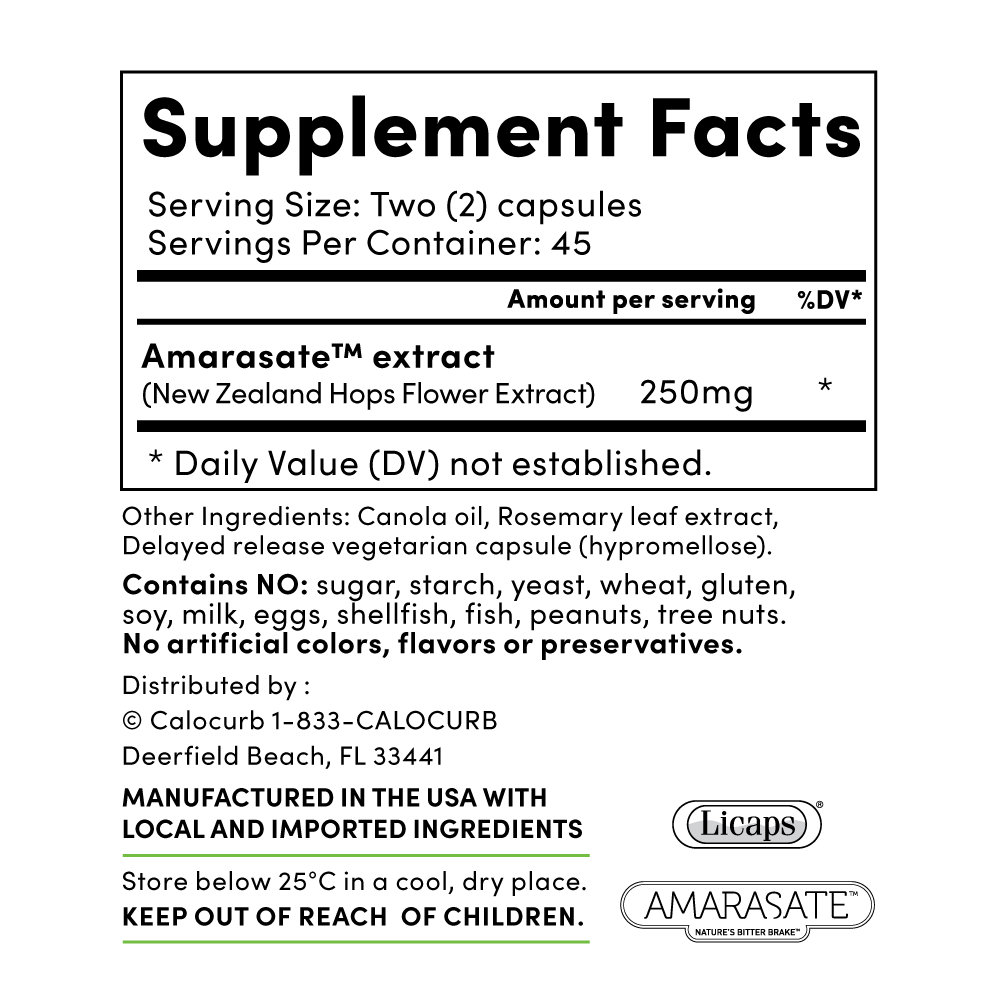
With the massive interest in the use of so-called “skinny shot” medications such as semaglutide (Wegovy and Ozempic) and tirzepatide (Zepbound and Mounjaro) you may be wondering just how they work—and how they differ from Calocurb, a plant-based capsule containing Amarasate that also curbs the appetite.
Production of GLP-1
The common factor for all three (semaglutide, tirzepatide and Amarasate) is a hormone called GLP-1 (glucagon-like peptide-1 to give it its full name, which hardly anyone ever does!), which helps control blood sugar levels and tells our brains when we're full. When we eat, our bodies naturally release GLP-1 from special cells in our intestines; it rises quickly after eating and then again a bit later. The GLP-1 travels to different parts of our body, like the pancreas and brain, to do its job. However, most of the GLP-1 we make gets broken down quickly by a specific enzyme in our bodies called DPP-4.
GLP-1 Receptors
Receptors exist throughout our body, like little docking stations for different molecules. GLP-1 works by attaching to its specific receptors; you can think of them as ‘locks’ that GLP-1 ‘keys’ fit into. They're found in places like the pancreas, gut, and brain. When GLP-1 attaches to and activates these receptors, they produce different effects, depending on where the receptors are located.
Effects of GLP-1 Receptor Activation
GLP-1 has many roles in our body, only some of which are fully understood. Within the digestive system, it slows down stomach emptying, increases insulin production to help regulate blood sugar, and helps the liver take up glucose. In the brain, GLP-1 works to make us feel full (technically called ‘to increase satiety’). The delayed stomach emptying and feeling full are basically signals to stop eating, so you can think of GLP-1 as the ‘you’ve had enough to eat’ hormone.
GLP-1 affects how our heart works by increasing heart rate and blood pressure. It may also help our muscles use glucose better and affect fat storage. In addition, there is much interest in other roles GLP-1 may have within the brain, for example, in addictive behaviors.
How Amarasate Works
Amarasate is a natural supplement made from bitter hops flowers grown in New Zealand. It works by stimulating ‘bitter taste receptors’ that trigger the release of GLP-1 and other helpful hormones. Curiously, taste receptors are not present just on our tongues; they’re found throughout our gut! (Who knew?!) When activated by Amarasate, the bitter taste receptors produce twice as much GLP-1 as usual. The increase in the natural production of GLP-1 it causes makes you feel full faster and so can help reduce appetite and food intake.
(When you think about it, it makes evolutionary sense that bitter substances would stop you eating...back when we were hunter gatherers, if we ate a bitter plant it may well have been poisonous, so best not to eat more of it!)
Amarasate is the active ingredient in Calocurb capsules. You take it about an hour before eating. Start with one capsule a day and slowly increase to two capsules before two meals if needed. Some people may need fewer capsules to feel the effects either because their bitter taste receptors may be extra sensitive to Amarasate (producing an even bigger spike in GLP-1) or because their bodies are extra sensitive to the effects of GLP-1. Others may need to take more Calocurb to feel so full that they reduce their diet enough to lose weight.
Studies in both men and women have shown that Amarasate® can help reduce hunger and food cravings when fasting for 24 hours. A new study is underway that will measure how much weight participants lose while using it over 6 months. In fact, Amarasate has been clinically proven to reduce hunger by 30%, food cravings by 40% and calorie intake by 18%.
Amarasate® has few side effects: some people may experience diarrhoea when they start taking it, but this usually goes away and can be reduced by starting it slowly and gradually building up the dose. Nausea is rare with Amarasate.
How ‘Skinny Shots’ Work
Semaglutide and tirzepatide are so-called ‘GLP-1 receptor agonists’. That means they are molecules that mimic natural GLP-1. They are just two examples; some are mimics of natural GLP-1 but are resistant to the DPP-4 enzyme, while others are animal-derived and are very close to the human molecule. Either way, they work like sufficiently similar ‘keys’ to fit into the GLP-1 receptor ‘locks’ and activate them. They are mostly injected beneath the skin (though there is an oral form of semaglutide available, called Rebelsus) after which they flood the body, producing much higher, more constant and long-lasting levels than it is used to with respect to natural GLP-1.
Injected once-weekly (or swallowed once daily), GLP-1 agonists are often used to treat diabetes by lowering blood sugar and are also used to help lose weight. However, they commonly cause gut side effects like indigestion, nausea, vomiting and diarrhoea; more severe gastrointestinal side effects have also been reported. In addition, they may cause dizziness, headache and a mild increase in heart rate. Around 10% of people in clinical trials stopped using them.
The very high and constant levels of GLP-1 agonists that occurs after they are injected probably explains both their beneficial effects and their side effects, for example, activation of the part of the brain that makes us feel nauseous. Side effects related to these agents are likely to last for some time, as they are only slowly metabolized in the body. In contrast, Amarasate mimics the natural cycle of GLP-1 production, but at twice the levels that normally occur in response to food intake; this likely explains why it's less likely to cause nausea compared to other GLP-1 medicines.
Conclusion
Both Amarasate and GLP-1 agonists can help with weight loss by slowing stomach emptying and increasing fullness, thus reducing food intake. Drugs like semaglutide or tirzepatide can be considered external ‘simulators’ or ‘mimics’ of the GLP-1 hormone, whereas Amarasate is a ‘stimulant’ of our own internal GLP-1. Amarasate may be a gentler option for some people, especially those who have trouble with side effects from other medicines.
- Written for Calocurb by Dr. Tracey Lambert





